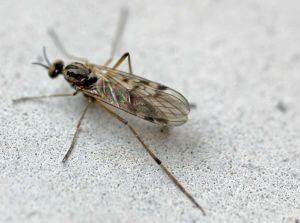Mistaken IDs
INSECTS COMMONLY MISTAKEN FOR MOSQUITOES
CRANE FLIES (TIPULIDAE)
Crane Flies (Tipulidae) are delicate insects varying in size from ¼ inch to as large as 1½ inches in length. The largest crane flies are sometimes called "daddy-long-legs", "gully nippers", or "mosquito hawks". However, they do not bite people and they do not eat mosquitoes. Some species of crane flies emerge from aquatic sources and others from terrestrial or decaying vegetation sources. Crane flies are not predacious and usually many times larger than a typical mosquito. Adults are strongly attracted to porch lights. The larvae live in loose soil or organic matter and feed on the roots of plants.
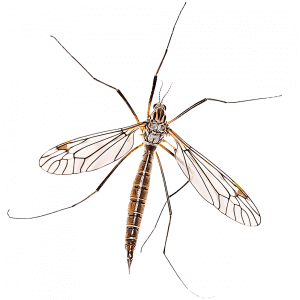
MAYFLIES (EPHEMEROPTERA)
Mayflies (Ephemeroptera) can be quite abundant near creeks, flood control channels and other water sources throughout the United States. Their larvae are found in most aquatic habitats and can live in moving water. Adult mayflies are recognized by the way they hold their wings at rest and the presence of two or three long "caudal" filaments at the tip of the abdomen. Though not even closely resembling mosquitoes, their seasonal occurrence at porch lights and on the walls of buildings near their aquatic breeding sources invariably attracts the attention of some concerned residents. The nymphs of mayflies develop in all types of aquatic habitats where they form an important part of the food chain. Adults are among the most short lived in the insect world.
They generally survive hours to a few days after emergence in order to mate and lay eggs. Huge swarms of adult mayflies, in recent years (1995-97), have become a nuisance by their presence in some communities along the western basin of Lake Erie. Most swarming occurs in late June and early July. Mayflies accumulate around lights, making roads, streets, sidewalks, etc. slippery and dangerous. These annoying insects may fly into one's face, ears, hair, land on clothing, crawl behind eyeglasses and splatter car windshields. Along lake shores, piles of decaying bodies drift onto beaches and, if not removed, an offensive fish-like odor occurs discouraging tourists during the July 4th holidays. Also, some people are hypersensitive, displaying symptoms of hay fever and asthma (allergies) from inhaling airborne pieces of their dead fragmented bodies. Mayflies do not bite or sting nor feed on homes, furnishings, food, etc. (Their presence is an indicator of clean water and a healthy environment.) The chief importance lies in their value as food for fish, dragonfly nymphs and birds. Anglers imitate the adults in dry flies, referred to as "spinners" or "duns," and pattern wet flies after the nymphs (Naiads).
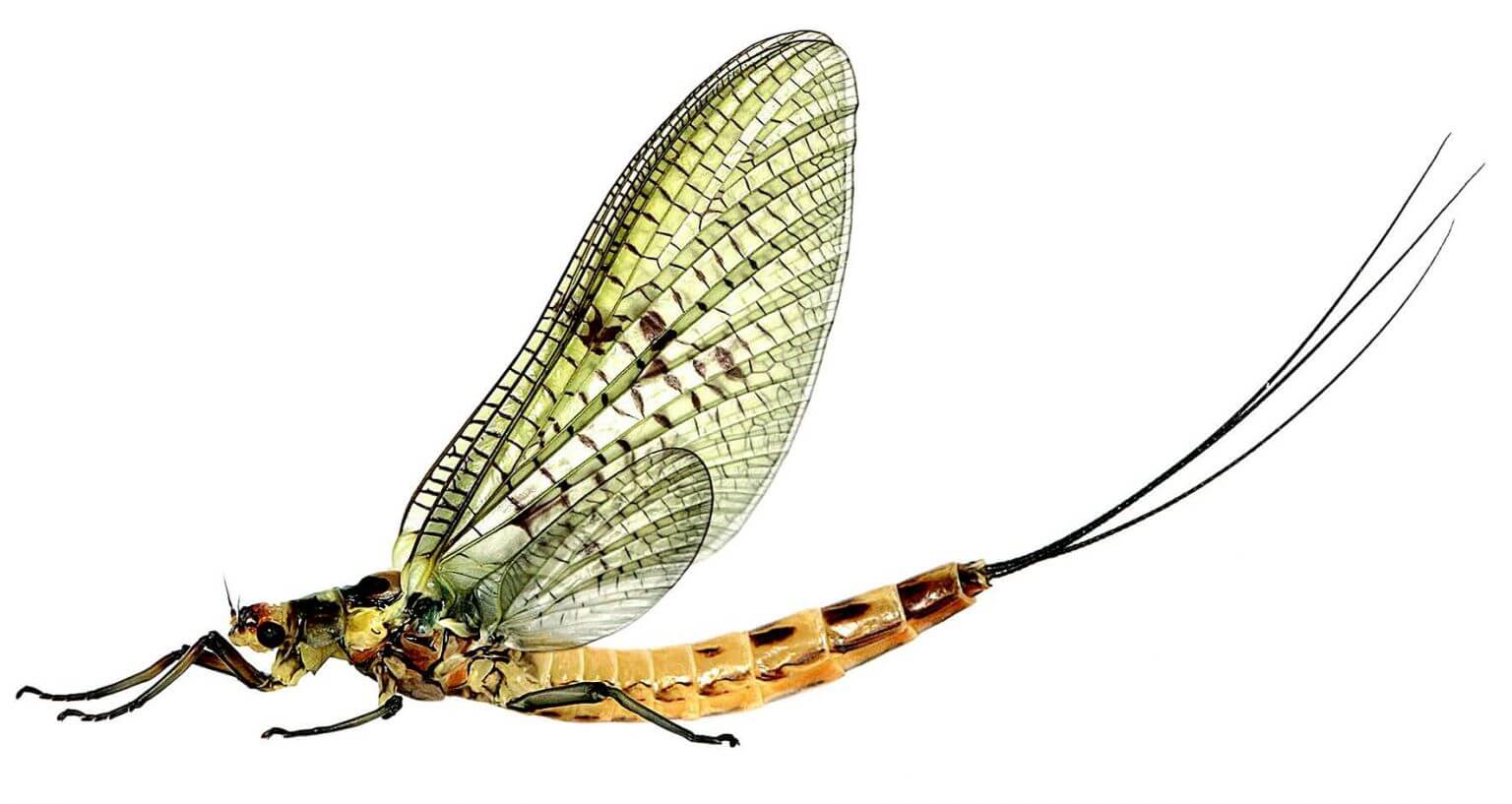
MIDGES (CHIRONOMIDAE)
Midges (Chironomidae) are the most wide spread and numerous insects resembling mosquitoes. Adult Midges are commonly observed flying in swarms or "clouds", or are seen resting on fences, walls, under eaves and in protected areas such as porches and entryways. Individual adults will live about seven days depending upon the species and weather conditions. The larvae develop in sources having extensive areas of standing water.
Chironomid midges develop in moist soil, lakes and slow moving rivers. The larvae scavenge decaying organic matter, feed on algae and other phytoplankton and the midges themselves can be an important part of the diet of fish. Although adults may emerge and be found during almost any time during the warmer seasons, emergences are often fairly synchronized, apparently being triggered by changes in weather patterns.
What attracts attention are the towering mating swarms that many midges produce. These form over some prominent point or conspicuous, usually light-colored object. This may include automobiles, a piece of lawn or porch furniture, or even a human. These mating swarms are made up almost entirely of the males. When the wingbeat frequency of approaching females is detected, a few will dart out to meet and mate with her. Because of the sensitivity of the swarming males to sound you can often see erratic changes in the swarm pattern in response to sounds such as a handclap or even spoken word.

DIXID MIDGES (DIXIDAE)
Dixid Midges (Dixidae) are common around moist areas where vegetation is abundant and may be seen swarming at dusk along the edges of streams and lakes. The adults are short lived, usually being active less than a week. The larvae are found in slow moving water, at the surface, and swim in a characteristic "U" shape. These midges lack a proboscis and scales on the wings. Periodically, dixids can produce staggeringly large emergences, but only in local and certain ecological situations.

FUNGUS GNATS (SCIARIDAE)
Fungus Gnats (Sciaridae) are small (about ¼ inch long), black flies commonly found around decaying vegetation. They have large wings and long antennae, but they are weak flyers and do not move far from the breeding site.
Fungus gnats occasionally become a nuisance indoors when adults emerge in large numbers as mosquito-like insects from potted plants or flower boxes containing damp soil rich in humus. Adults are attracted to lights and are often first noticed at windows. In the household, fungus gnats are usually found around potted plants, because both the adult fly and the larvae require a humid environment. The larvae can complete their development by feeding on the wet and decaying organic matter in potting soil. The lifecycle may be completed in about 10 days, and the adults may live about 2 weeks.
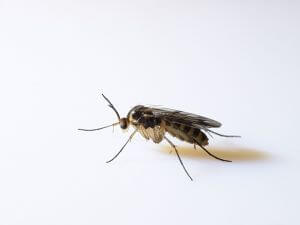
DANCE FLIES (EMPIDIDAE)
Dance Flies (Empididae) appear like mosquitoes by the way they swarm in sunlit areas in backyards and other sheltered situations. The vertical movements of the swarming adults gives them their common name. Several of the Empis species are "balloon makers." That is, the male flies capture an insect and enclose it in a frothy bag that they carry as a lure to entice the female to mate. Some species dispense with the froth, capturing and displaying live flies in front of females as a preface to courtship. Others trick their intended with an empty ball of silk. Larvae are usually found in rich, moist soil, decaying vegetable matter and in aquatic associations, or under the bark of trees.
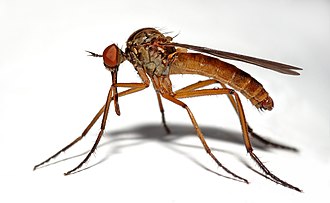
WOOD GNATS (ANISOPODIDAE)
Wood Gnats (Anisopodidae) are some of the better known gnats, for they are attracted to light and can be found near windows, especially in spring time. The adults can be found all year long, though. The larvae live in rotting plants and rotting plant parts, fermenting sap, animal manure, tree trunks, mud and sometimes sewage. Adults are found on foliage in or near damp places, some are found around flowing sap. They are sometimes seen in small swarms. Adults appear in two variations: greyish black or reddish.
